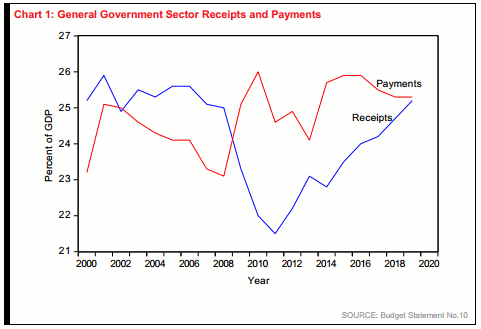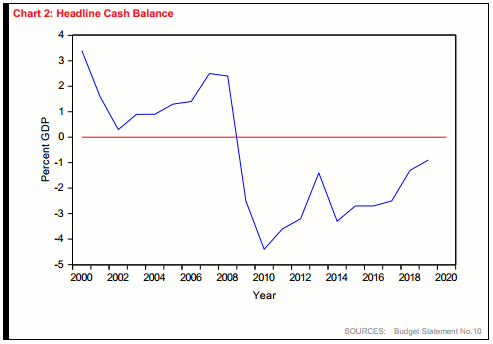This time last year, we noted that the budget was one of pretend austerity. Much of the debate following the budget then pretended that the austerity was real. It was not real austerity then and it is not real austerity now. In Chart 1 below, drawn from Statement No.10 page 6, we see the payments of the budget as a percent of GDP. Last year the budget was for year 2014/15.
In that year, payments grew to 25.9% of GDP. This was UP from 25.7% of GDP the year before.

Advertisement
The current budget year is 2015/16. Payments are again expected to be 25.9% of GDP in this budget year. There is only a mild decline in outlays in the next three years. Payments ease to 25.5% of GDP in 2016/17. They further ease to 25.3% of GDP in 2017/18. Payments then remain stable at 25.3% of GDP in 2018/19. If last year is a guide, this stability in expenditure will come to be attacked as cruel and unfeeling austerity.
At the same time though, the budget deficit is being addressed. Revenue is expected to grow.
In 2014/15 revenue is expected to be 23.5% of GDP. This should grow to 24.0% of GDP in 2015/16. Revenue should recover in 2016/17 to 24.2% of GDP. It should grow further in 2017/18 to 24.7% of GDP. In 2018/19 revenue should rise further to 25.2% of GDP. This process of stable spending and rising revenue moves to reduce the deficit.
In Chart 2 we see the improvement in the General Government Cash Balance. As well as payments, the cash balance includes net cash flows from investments in financial assets. This gives us a slightly different result than the simple difference between receipts and payments. In 2014/15, the headline cash deficit was 2.7% of GDP. In 2015/16 the headline cash balance should remain at 2.7% of GDP. However, in future years the deficit declines.
This deficit should fall to 1.3% of GDP in 2017/18. It should decline again to 0.9% of GDP in 2018/19.
This kind of decline should be enough to stabilize Australia's sovereign debt relative to the size of Australian GDP.
Advertisement

Where is the money going?
In Table 1 below, we see the outlays in this budget and the sectors where the money is being spent. The total outlays under this budget are $434.5 billion. By far the biggest area of expenditure is on Social Security and Welfare. Expenditure here is 35.4% of the budget. Total spending on Social Security and Welfare is $154 billion. This is more than twice the level of spending on Health. Health spending is $69.4 billion. This is 16% of the budget. Education, the next in line, sees spending of $31.8 billion. This is 7.3% of the budget.
Discuss in our Forums
See what other readers are saying about this article!
Click here to read & post comments.